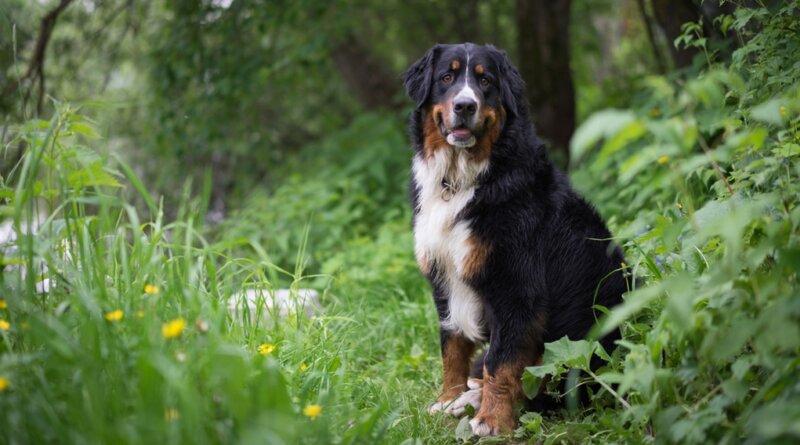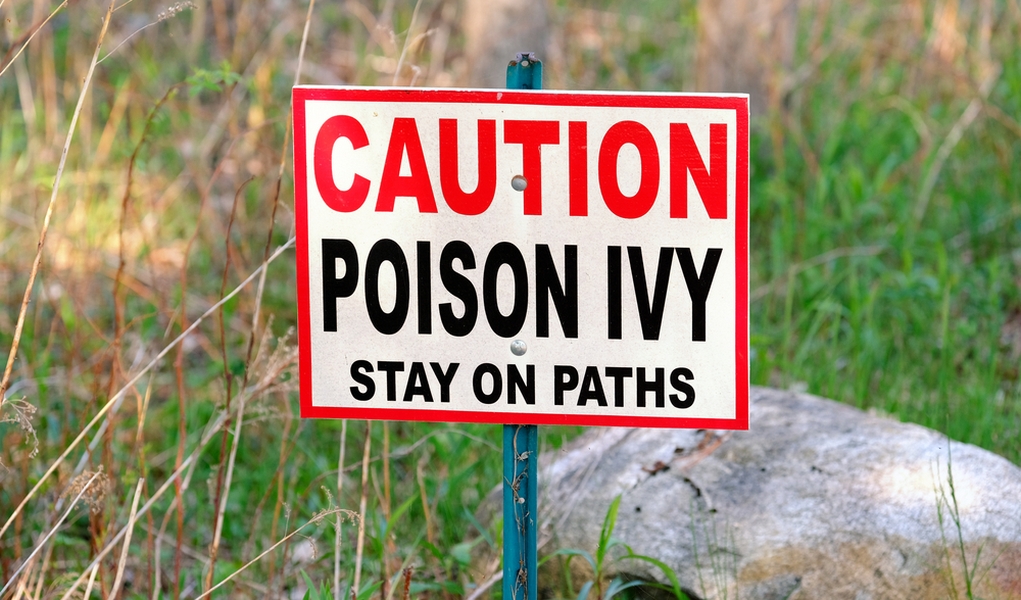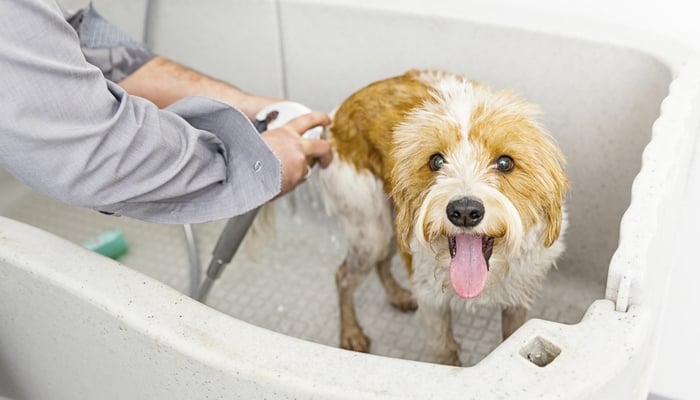Can Dogs Get Poison Ivy and What to Do?
The short answer is yes.
Poison Ivy is a plant that grows in sunny or partially shaded areas, most notably around trees or rock formations.
It possesses oil, otherwise known as urushiol.
This oil can be picked up by your dog just brushing past it.
Is ivy poisonous to dogs?
The result of poison ivy oil getting on your dog’s skin is almost always immediate contact dermatitis.
The severity of this depends on whether a large or small area of your dog’s skin was exposed and your pet’s level of natural resistance to the plant (which cannot be measured).
When ingested, this poison is more severe and can even be deadly.
After being consumed, in the best case scenario, it can result in blistering of the dog’s stomach and burning of the throat and mouth.
The symptoms of poison ivy on dogs include:
- extreme itching
- raised red rash with oozing blisters
- pain in the stomach area
- vomiting (in the case of ingestion)
What to do if your dog comes in contact with Poison Ivy?
We’ll get into more details on this below, but know that when your dog has touched the plant, you must bathe him immediately with a sensitive shampoo. Use gloves, and wash any paraphernalia including towels and your clothes straight away afterward to avoid the spread of the oil throughout the house.
If your dog has ingested the plant, you have to contact and get him to your veterinarian immediately.
The result of your dog consuming poison ivy can be deadly if not treated right away, but if caught quickly (and if the dog hasn’t eaten much), you have a good chance of full recovery.
Here’s what you need to know about poison ivy plants and dogs.
Poison Ivy and Dogs
What is Poison Ivy?
The Poison Ivy (Toxicodendron radicans) plant and variants are also known as Three Leafed Ivy, Bois de Chien, and Poison Oak – members of the Anacardiaceae family.
The weed is synonymous with an unpleasant itching, and other allergic reactions and skin reactions thanks to the clear oil like substance or urushiol that it produces.
To spot poison ivy, keep an eye out for three leaves on a woody stem.
The color of the leaves depends on the maturity of the plant, with young plants showing light green and older one’s darker green.
Here’s what poison ivy looks like:
Don’t get caught out in the fall. With the leaves changing to a dark red color, this is when people don’t notice them and let their dogs off the leash without a care in the world.
Growing throughout most of North America, you’ll find this at the base of trees, standing alone as a bush or in vines.
Here’s how to spot them:
- Western poison ivy will never climb and will always be undergrowth
- Eastern poison ivy can look like both undergrowth or a climbing vine
Can dogs get Poison Ivy?
Again, the answer is a definite yes.
Dogs can, and often do suffer the ill effects of poison ivy.
Most commonly when out hiking, playing fetch or when allowed to roam in wooded areas.
Symptoms of Poison Ivy on Dogs
An intense itching typically identifies it on the skin.
Raised bumps will soon appear on your dog’s skin, resembling blisters more than a rash.
As the condition worsens and the oil can get deeper into his skin, these blisters may begin to pop or ooze.
Other common symptoms of a poison ivy infection include:
- an itchy rash
- reddening of the skin
- chewing, licking, or biting at themselves
- vomiting
- abdominal pain
- scabs and blisters on the skin
- diarrhea
RELATED: 6 Dog Skin Conditions and What To Do About Them
How Serious Is It?
Being struck down with poison ivy is a significantly uncomfortable experience, whether for a person or a dog.
The level of intense itching depends on the exposure to the oils of the plant.
No matter the exposure, you need to wash and treat your pet immediately.
When exposed to the skin alone, there is rarely cause for concern.
, but in cases of ingestion from more sensitive dogs, it can lead to death if not treated.
Even in mild cases of external exposure, a large cause for concern is when dogs gnaw at the afflicted areas and cause wounds to themselves, which can then become infected.
Breeds That Are More at Risk
There doesn’t seem to be any evidence of a particular breed that is more prone genetically to a severe allergic reaction.
However, many breeds with incredibly short coats do suffer the most because of their chances of exposed skin is higher.
These breeds include:
- Dachshund
- Chinese Crested
- Mexican Hairless
- Pit Bull
- Greyhound
- Bulldog
- Boxer
- Jack Russell
- Short Haired Chihuahua
- Hungarian Vizsla
- Whippet
Whereas very fluffy breeds such as the Hungarian Kuvasz, St. Bernard, and Bernese Mountain Dog are given a reasonable level of protection from the majority of contamination.
Having said that, the thicker, fur-coated breeds can still easily pick up oil from these plants. However, they most likely won’t develop an itchy rash.
This is dangerous for a number of reasons.
First of all, your dog may track the oil into your home, which could cause you to have an allergic reaction.
The oil can also work its way down to the skin through the hair, and bathing a dog thoroughly is pretty hard work.
Finally, from having the oil on the dog’s fur, your pet can easily ingest it. This is far more dangerous than skin exposure.
This can cause either an upset or, worse, anaphylactic shock.
Is Poison Ivy Contagious?
Poison ivy oils can spread from dog to owner or vice versa. Longer-haired breeds can brush up against the plant and pick up the oils and carry it into the home.
You might not notice before it’s too late.
Because the pet’s coat protects your little fluff ball, the oil may not reach the skin, and therefore your pooch will be symptom-free.
But, if your dog is allowed on the couch or the bed, as soon as you come in contact with that surface you’re likely to be affected.
If you or anyone has come in contact with it and start developing a rash avoid petting the dog until they’ve been washed.
RELATED: Skin Tags On Dogs – 8 Ways To Prevent and Treat Them
Home Treatments for Poison Ivy on Dogs
It’s difficult to do more than keep a lookout for the plant and keep your dog away from these areas.
Some owners with especially rambunctious pups have been known to pop a full body suit and booties on their pooch to defend from this horrible little plant.
1. Washing
As soon as you suspect that your dog may have come into contact with the plant – give him a warm bath with a mild shampoo, either puppy or baby shampoo would work best.
The reason that you need to use a mild shampoo is due to the irritation and inflammation that will already be occurring from contact with the plant.
Always wear gloves when washing a dog with poison ivy to minimize your risk of getting the oil onto your own skin.
Use warm water.
Be sure to wash your dog thoroughly.
The oils will be hiding down near the base of the hair at the skin, which is not only where it can cause the most irritation, but it’s also the hardest to get squeaky clean.
Towel dry your pooch as soon as you have finished bathing him, then wash your clothes that you wore while in contact with him, as well as the towels, immediately.
2. Apple Cider Vinegar
The wonder solution to everything it seems!
Everyone is talking about the benefits of apple cider vinegar, and it can also be used for a multitude of doggy health conditions both by ingesting and topically, including poison ivy on dogs.
For relief, after initially bathing your dog to remove as much of the oil as possible, you can take a spray bottle, and fill it with one part Apple Cider Vinegar, and one part cold water.
Shake to ensure that everything is mixed thoroughly.
Now spray on mist setting over your dog’s coat, being very careful around the eyes, nose, and mouth.
The vinegar may sting immediately, but this will only last for a minute or so.
It will then provide around one hour of itch relief same way as many other itch relief products, as well as working to draw out and neutralize the toxins on the dog’s skin.
3. Calamine Lotion
If you get Poison Ivy, what do you treat it with? Probably calamine lotion is somewhere at the top of the list, and this treatment is generally safe for your pet, too (topically).
This is often the go to itch relief for many conditions, but as the active ingredient is Zinc Oxide, it’s not always the best solution for dogs.
For any medication applied topically, it’s important that it won’t cause medical issues if ingested, or that the dog is not able to get at it to lick the area.
This lotion can, of course, provide relief to the intense itching, but it’s important that you use a cone collar on your pooch after application as it can cause an upset stomach and vomiting if he does lick it off.
4. Coconut Oil
If your dog has severely irritated skin, or if he has chewed at it to relieve itching, you may need to find a milder solution to apply to his skin.
Coconut oil has been shown to be effective in relieving the itch when applied to the skin post-bath.
It doesn’t cause the stinging sensation that other products, such as Apple Cider Vinegar, can. Plus, coconut oil has many other benefits to aid in the dog’s skin and coat health.
5. Oatmeal and Aloe Shampoo
If there is an ongoing risk of your dog running into the plant, buy a dog shampoo with oatmeal.
This provides additional itch relief and helps to heal the affected skin.
There are natural pet product companies that offer oat shampoos, including Earthbath, that’s one of the best shampoos around, and they produce Oatmeal and Aloe shampoo for dogs.
It’s not only for poison ivy on dogs; this shampoo can also be used as your main shampoo, especially if your dog suffers from sensitive skin.
6. Avoid The Woods altogether
Most of the time, your poison ivy and its oily sap are typically found in wooded areas.
Just have them avoid this area by setting up an electric fence.
RECOMMENDED VIDEO GUIDE: How To Bathe A Dog 101
Veterinary Treatments for Poison Ivy on Dogs
We know dogs can have a reaction to this dreaded plant and that it’s dangerous for dogs, just as it is for us.
Depending on the severity of the reaction your dog has, skip home treatments and schedule a vet visit.
Especially when a dog suffers from an autoimmune condition – his body’s healing defenses may be slower, which can increase the risk of infections setting in.
Your vet will know how to treat poison ivy effectively and fast.
1. Topical Antihistamine Medication
If your pooch has a particularly aggressive itch outburst, your vet can apply a topical ointment to the affected area.
The active ingredient of most antihistamine creams is hydrocortisone – this helps to soothe the skin without causing adverse side effects associated with injectables.
2. Benadryl
Yes, Benadryl is can be safe for dogs, but the proper dosage is crucial.
It is worth checking with your vet before you first administer this, as dogs with underlying health issues may have adverse effects.
Benadryl works as an antihistamine and can help to minimize your dog’s reaction to the urushiol within the plant.
3. Charcoal
The first sign of poison ivy on dogs will likely be vomiting, with your pet’s body doing its best to rid itself of the poison.
Take your dog to a vet right away, where the vet can administer charcoal to help defend the body or in some cases, pump the dog’s stomach.
4. Antibiotics
As the very last resort for poison ivy on dogs, and only in the most extreme cases will antibiotics be given, usually where the dog has ingested the plant and requires additional support to rectify any internal damage.
Final Thoughts
Can dogs get poison ivy?
Yes, they absolutely can. Is ivy poisonous to dogs?
It is, just like it’s poisonous for humans.
Prevention is the best cure, as with everything else, so if you know what to avoid and plan your trips well, the chances are low.
Anyone that has suffered the ill effects of this plant can attest to the severity of discomfort that it inflicts upon its victims.
As much as it can seem like a good idea to let your dog off to run through the woods, it’s always best to look around thoroughly first (or better yet, just keep your pooch on the leash).
READ NEXT: 15 Cheap Ways To Prevent Most Common Health Issues In Dogs










